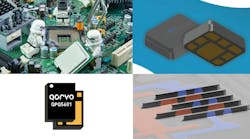Exploring the Possibilities—and Challenges—of Designing to 300 GHz
What you’ll learn:
- The challenges of tighter manufacturing tolerances at higher frequencies, including the need for precision in component placement and interconnects.
- Integration and packaging challenges with an emphasis on the importance of managing parasitics and exploring alternative solutions like flip-chip and chip-scale packaging.
- Semiconductor materials play a critical role in high-frequency designs, with a shift toward integrating more functionality into a single chip to minimize interconnects and maintain performance.
The world of radio-frequency (RF) and mmWave communications is rapidly advancing toward harnessing the potential of ultra-high frequencies, reaching 300 GHz and beyond. This journey, while filled with promise, is laden with challenges. Here, we’ll explore the considerations involved in designing and manufacturing at 300 GHz, delving into the difficulties, evolving technologies, and the need for innovation to make this a reality.
The internet has become an integral part of our daily lives, facilitating activities such as information exchange, social networking, banking, and online shopping. As we step further into the era of the Internet of Things (IoT)—where a web of smart devices seamlessly connects—the possibilities are endless. These IoT applications are poised to reshape everything from the way that our households run to modern businesses and manufacturers.
To meet these needs and keep up with the ever-increasing demand for data, 5G and 6G wireless networks must push the boundaries further. The most likely early implementations of these higher-frequency bands will be in backhaul (effectively the data pipe between the base station and the core network simultaneously serving the data needs of all network users.
Although mmWave and E-band (71 to 86 GHz) have delivered major leaps forward with data rates in excess of 10 Gb/s, what comes next is now capturing people’s attention and creating the biggest challenges. Let’s explore some of these challenges in greater detail.
Manufacturing, Integration, and Packaging Challenges
Manufacturing tolerances stand out as a significant hurdle when dealing with high-frequency designs. As frequency rises, the demands increase for tighter tolerances on component placement, interconnects, and metalwork. Traditional manufacturing methods, such as CNC machining used to create the waveguide for signal conditioning, might lack precision. This forces the adoption of new production methods such as additive manufacturing to achieve the required tolerances.
Moreover, the journey from lower frequencies to 300 GHz involves the development of smaller semiconductor features, especially for high-power devices. For compound semiconductor devices, this progress is slower due to limited demand and increased complexity. The development of these processes is driven by the emergence of new applications and business cases, making it a lengthy and costly journey.
One of the paramount challenges in high-frequency design is the management of parasitics. A good example would be wirebonding at lower frequencies. The impact of parasitic elements can be mitigated with relative ease, but as we move to mmWave frequencies, it becomes necessary to design a matching network to cancel out the parasitic effects.
When moving to 300 GHz, this becomes impractical as manufacturing tolerances mean that a different matching network would be required for each new bond—clearly impossible in a volume production environment. To overcome these challenges, a shift toward alternative packaging and interconnect solutions for semiconductor devices becomes imperative. Work has already started on such designs, including flip-chip, hot vias, and chip-scale packaging.
At these high frequencies, semiconductors become a critical focal point in the overall design. Each semiconductor material has unique properties that can support the critical design requirements. At lower frequencies, a mix of performance and cost often leads to the integration of several individual semiconductors. For higher frequencies, the aim will be to integrate as much of the functionality as possible into a single chip to minimize interconnects and the related problems outlined above.
It’s therefore likely that much of the integration will be in the form of a silicon chip with the high-performance elements, such as the power amplifier and LNA, having to remain in a compound semiconductor material to maintain the required performance. As it stands today, the processes don’t exist with the performance to meet the power required to form wireless data links, but these will evolve in the coming years.
Thermal-Management Challenges
With each stride toward higher frequencies, the efficiency of electronic devices experiences a noticeable decline. This means that more DC power is required to achieve the same RF output power. It clearly calls for larger power supplies, but more critically, leads to the dissipation of more power in the form of heat.
Compounding this challenge is the continual miniaturization of electronic circuits. As components and devices become smaller and more densely packaged, the heat generated is concentrated within a reduced physical area. This concentration of heat amplifies the importance of effective thermal management. Failing to adequately dissipate this heat can lead to various issues, including reduced device performance, reduced lifetime, and even device failure.
To address these thermal-management challenges, the industry is actively exploring innovative solutions. This starts at the critical interface between the semiconductor device and the heatsink. It leads to a requirement for innovative materials in epoxies, sinters, and solders to remove heat from the device while maintaining an expansion coefficient with the other materials around it to remove stresses and strains, which can again lead to device aging or failure.
Once the interface is controlled, heat must be quickly spread. Here, heat spreaders are deployed with materials such as copper, molybdenum, and even diamond, used for its enhanced thermal properties. Once the heat is spread, it must be effectively removed, leading to requirements for forced air convection or liquid cooling.
Manufacturing Constraints: Precision Prevails
Manufacturing at high frequencies introduces a whole new realm of intricacies. Precision becomes the bedrock of this endeavor, with an unyielding demand for tight tolerances in critical areas such as component placement and epoxy dispensing.
The high-frequency landscape leaves little room for error, and even minuscule variations in component placement can result in severe consequences. The challenge, therefore, lies in the development of machinery capable of producing high volumes with impeccable precision.
The pursuit of precision in manufacturing for high frequencies often necessitates the creation of custom machinery. Off-the-shelf solutions may prove inadequate when dealing with the exacting requirements of these designs.
As a result, manufacturers are driven to invest in tailor-made, precision-focused equipment that can meet the stringent demands of high-frequency production. This tailored approach, while addressing the need for precision, adds an additional layer of complexity to the manufacturing process.
In essence, the challenge in high-frequency manufacturing extends beyond the design and engineering phases. It's not just about creating high-frequency designs, but making them viable for mass production. The intersection of precision, custom machinery, and evolving manufacturing techniques creates a nexus of complexity and opportunity.
As the industry strives to lead the way in RF and mmWave communications, it must navigate these manufacturing constraints with ingenuity and unwavering commitment to achieving the desired precision in high-frequency electronic systems.
In the high-frequency landscape, it's not merely a journey of technological progress—it’s a relentless pursuit of precision; precision in design, manufacturing; and achieving the desired performance at these as-yet-unreachable frequencies. Although designing solutions to 300 GHz is possible, achieving production at scale for such high frequencies is still an elusive goal. It’s not today’s technology, but a vision for the future.
About the Author
Tudor Williams
Director of Technology, Filtronic plc
Before joining Filtronic, Tudor was interim director of technology at the Compound Semiconductor Applications Catapult, where he built a team of skilled engineers and an advanced measurement and characterization facility from scratch. Tudor also worked as engineering manager at Mesuro, a startup company spun out of Cardiff University and sold to Focus Microwave in 2016, and as a MMIC design engineer at Selex Sensors and Airborne systems.


